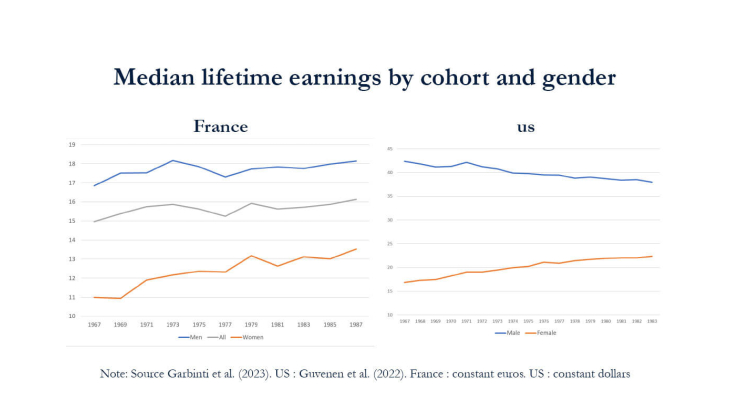Cross-sectional measures of earnings inequality have been widely used to assess the dynamics of inequality over time and for cross-country comparisons. However, such point-in-time measures of inequality have limitations. In particular, they do not reflect income mobility over the life cycle and are affected by transitory income shocks. Therefore, a broader perspective based on lifetime earnings, i.e. looking at the earnings of a cohort over its entire life cycle, can significantly enrich the analysis. The analysis of the dynamics and distribution of lifetime earnings has however been limited by data availability, and the bulk of recent contributions focuses on the US. Existing work for the US has found striking patterns, with male lifetime earnings exhibiting a decline in their median across cohorts and a sharp increase in inequality. Based on cross-sectional data, a vast literature has found that both trends in average earnings and their dispersion have followed different paths in the Western European economies when compared to the US, notably with the latter exhibiting much higher levels of earnings inequality than the former. This raises the question of to what extent these differences still hold when one considers lifetime rather than point-in-time earnings.
We address this question by providing estimates of lifetime earnings (for a large European country, France, and compare our results with those of Guvenen et al. (2022a) for the US. For comparison purposes, we follow closely Guvenen et al. (2022a) in terms of sample selection and lifetime earning computation. As they do, our lifetime earnings measure is defined as the average earnings over the 31 potential working years between ages 25 and 55. Our core sample consists of the cohorts born between 1942 and 1962, who turned 25 years old between 1967 and 1987. We refer to cohorts by the year in which they turned 25.
First, we analyze the trends in median and mean lifetime earnings in France and compare their dynamics and age profiles with those in the US. Although the overall pattern for the entire population is similar in France to that observed in the US (i.e. a flat curve since the late 1960s/early 1970s), we unveil major differences between the two countries. In France this results from a moderate increase for both genders together with increased female participation, while in the US, lifetime earnings decline for men and sharply grow for women (see Figure below). The age profiles across cohorts also differ from those observed in the US. Our results for France indicate that the stability of male median lifetime earnings across cohorts hides a significant change in the pattern of their yearly earnings over their life cycle. Starting with the late 1970s cohorts, there is a decrease in entry wages, which has been nevertheless compensated by faster earnings growth between ages 35 and 55.
Second, we assess how lifetime inequality has evolved over time. We find that inequality in lifetime earnings is much lower in France than in the US over the whole period we study. While Guvenen et al. (2022a) report a steady increase in the US across cohorts, France exhibits moderate changes, displaying a U-shaped pattern with inequality first falling and then increasing from the 1979 or 1981 cohorts onwards. For the most recent cohorts, only the top of the distribution experienced earning gains, which raises the question of whether France is on a path of growing inequality too, albeit with a lag with respect to the US. Regarding the comparison between lifetime and cross-sectional measures, we find that inequality is lower for lifetime earnings than in the cross-section, yet in both instances, the data display a comparable U-shaped broad pattern.
Third, we analyze how the roles of education and working time in shaping lifetime earnings and the gender gap have evolved across cohorts. We find a sharp drop in the return to all education qualifications other than a master’s degree (and above) across cohorts, for both men and women. The fall in returns to education plays a key role: had the returns to education remained at their 1967 level, the growth in earnings experienced by men between the 1967 and the 1987 cohorts would have been twice as fast as the growth of mean earnings we actually observe. The change in education attainment has also played a major role: given the fall in the return to all educational qualifications other than a master’s degree, had the distribution of education observed for the 1967 cohort of men remained the same over time, lifetime earnings would have declined over the period instead of growing mildly. Comparing results for men and women allows us to assess the key aspects driving the evolution of the gender gap in lifetime earnings. In both the US and France, the lifetime gender gap has narrowed across cohorts. However, women’s lifetime earnings as a percentage of men’s are far larger in France where this percentage increases from about 61% to 70% (compared to about 41% to 60% in the US, see Figure below, dividing orange by blue line). We show that differences in working time explain an increasing part of the gender gap in lifetime earnings over time as both men and women have increased the number of years they work but women have done so largely through part-time employment.
